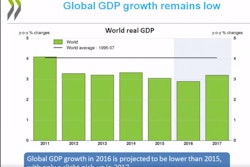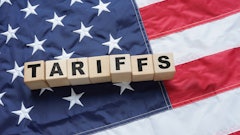Arlington, VA — July 3, 2007 — The broad swath of recent data reveals that the peak phase of an historically strong global expansion will continue for a longer period than most forecasts anticipated, according to a new quarterly report from the Manufacturers Alliance/MAPI.
In MAPI's "Quarterly Forecast of U.S. Exports, Global Growth, and the Dollar: Third Quarter 2007 through Fourth Quarter 2008," economist Cliff Waldman observes that signs of moderation in Chinese growth have, for the most part, reversed, and key Eurozone countries, especially Germany, are growing faster than expected.
In addition, Waldman writes that there is finally some momentum in Japanese consumer spending; emerging Asian nations appear to be recovering from an investment slowdown; and manufacturing growth in India has been north of 11 percent for three consecutive quarters.
U.S. Exceptionalism
It is the NAFTA region that seems to be the exception to this virtuous cycle of global strength, much of it due to weakness in the United States, according to the report. While there have been recent signs of improvement in the U.S economy, the housing situation remains a significant risk. "Until the residential investment downturn runs its course," Waldman writes, "short-term forecasts of U.S. economic growth will have larger than usual margins of error."
The report projects a slowdown in the annual growth of total U.S. goods and services exports, from 8.9 percent during 2006 to 6.4 percent during 2007, due primarily to slower industrialized country growth this year. As the lagged impact of a dollar depreciation takes hold and as both industrialized and developing country growth strengthen, total U.S. export growth is forecast to accelerate to 9.4 percent during 2008.
Growth in non-U.S. industrialized countries — which include Canada, the Eurozone (plus Denmark, the United Kingdom and Sweden) and Japan — is predicted to be 2.2 percent during the first three quarters of 2007. As the U.S. economy improves, MAPI expects growth to increase to 2.4 percent during the fourth quarter of 2007 and the first quarter of 2008, 2.6 percent during the second quarter of 2008, and 3.0 percent during the second half of 2008.
The developing country forecast stems from the expectation that the Chinese, Indian and Mexican economies will face an imminent slowdown period. Growth in the developing countries — which include China, India, Latin America, Mexico and the Pacific Rim (excluding Japan) — is projected to moderate from 5.2 percent during the second quarter of 2007 to 5 percent during the second half. Growth will further decelerate to 4.8 percent during the first half of 2008 before rebounding to 5.1 percent during the last six months, according to the MAPI report.
Down Dollar
Also, MAPI finds that the hazy U.S. economic outlook, in tandem with continual upside surprises in global growth outside of the United States, has created a renewed period of dollar depreciation.
As the currency market adjustment to slower and uncertain U.S. growth continues, Waldman predicts the dollar will decline by a sharp 15 percent against the currencies of industrialized trading partners during the second quarter of 2007. Following that, the dollar is expected to fall by 5 percent during the second half of 2007 and by 3 percent during the first quarter of 2008. MAPI forecasts the dollar to remain flat during the second quarter of 2008, and then appreciate by 3 percent and 4 percent, respectively, in the third and fourth quarters.
Against the currencies of the developing countries, MAPI predicts a decline of 5 percent during the second quarter of 2007 and then by 3 percent during the third and fourth quarters. If, as expected, China expands the trading range for the yuan and, as the Mexican economy and political situation continue to strengthen, the dollar is likely to depreciate by 6 percent in the first half of 2008, before becoming flat during the last two quarters as the U.S. economy returns to trend growth.
"The gap between global strength and U.S. weakness will allow for enough dollar depreciation to keep U.S. export demand moderately strong," Waldman said.
The full report is available at no cost to MAPI members, while non-members may order the publication for $50 through the MAPI Web site.
In MAPI's "Quarterly Forecast of U.S. Exports, Global Growth, and the Dollar: Third Quarter 2007 through Fourth Quarter 2008," economist Cliff Waldman observes that signs of moderation in Chinese growth have, for the most part, reversed, and key Eurozone countries, especially Germany, are growing faster than expected.
In addition, Waldman writes that there is finally some momentum in Japanese consumer spending; emerging Asian nations appear to be recovering from an investment slowdown; and manufacturing growth in India has been north of 11 percent for three consecutive quarters.
U.S. Exceptionalism
It is the NAFTA region that seems to be the exception to this virtuous cycle of global strength, much of it due to weakness in the United States, according to the report. While there have been recent signs of improvement in the U.S economy, the housing situation remains a significant risk. "Until the residential investment downturn runs its course," Waldman writes, "short-term forecasts of U.S. economic growth will have larger than usual margins of error."
The report projects a slowdown in the annual growth of total U.S. goods and services exports, from 8.9 percent during 2006 to 6.4 percent during 2007, due primarily to slower industrialized country growth this year. As the lagged impact of a dollar depreciation takes hold and as both industrialized and developing country growth strengthen, total U.S. export growth is forecast to accelerate to 9.4 percent during 2008.
Growth in non-U.S. industrialized countries — which include Canada, the Eurozone (plus Denmark, the United Kingdom and Sweden) and Japan — is predicted to be 2.2 percent during the first three quarters of 2007. As the U.S. economy improves, MAPI expects growth to increase to 2.4 percent during the fourth quarter of 2007 and the first quarter of 2008, 2.6 percent during the second quarter of 2008, and 3.0 percent during the second half of 2008.
The developing country forecast stems from the expectation that the Chinese, Indian and Mexican economies will face an imminent slowdown period. Growth in the developing countries — which include China, India, Latin America, Mexico and the Pacific Rim (excluding Japan) — is projected to moderate from 5.2 percent during the second quarter of 2007 to 5 percent during the second half. Growth will further decelerate to 4.8 percent during the first half of 2008 before rebounding to 5.1 percent during the last six months, according to the MAPI report.
Down Dollar
Also, MAPI finds that the hazy U.S. economic outlook, in tandem with continual upside surprises in global growth outside of the United States, has created a renewed period of dollar depreciation.
As the currency market adjustment to slower and uncertain U.S. growth continues, Waldman predicts the dollar will decline by a sharp 15 percent against the currencies of industrialized trading partners during the second quarter of 2007. Following that, the dollar is expected to fall by 5 percent during the second half of 2007 and by 3 percent during the first quarter of 2008. MAPI forecasts the dollar to remain flat during the second quarter of 2008, and then appreciate by 3 percent and 4 percent, respectively, in the third and fourth quarters.
Against the currencies of the developing countries, MAPI predicts a decline of 5 percent during the second quarter of 2007 and then by 3 percent during the third and fourth quarters. If, as expected, China expands the trading range for the yuan and, as the Mexican economy and political situation continue to strengthen, the dollar is likely to depreciate by 6 percent in the first half of 2008, before becoming flat during the last two quarters as the U.S. economy returns to trend growth.
"The gap between global strength and U.S. weakness will allow for enough dollar depreciation to keep U.S. export demand moderately strong," Waldman said.
The full report is available at no cost to MAPI members, while non-members may order the publication for $50 through the MAPI Web site.


















![Pros To Know 2026 [color]](https://img.sdcexec.com/mindful/acbm/workspaces/default/uploads/2025/08/prostoknow-2026-color.mduFvhpgMk.png?ar=16%3A9&auto=format%2Ccompress&bg=fff&fill-color=fff&fit=fill&h=135&q=70&w=240)
